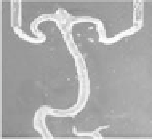Biomedical Engineering Reference
In-Depth Information
a)
b)
c)
d)
Figure 3.14
Elimination of relection and refraction effects: (a) Original
state, (b) after submerging in silicone oil, (c) original state, and
(d) after injecting silicone oil.
3.10
Silicone Membrane Thickness
Controllability
The production methodology presented makes possible to construct
very thin membranous silicone structure with uniform wall
thickness. The minimal attainable wall thickness was conirmed to
be about 100
μ
m, and this thickness is suficient to replicate the
cerebral arterial structure treated in intravascular neurosurgery.
Furthermore, its thickness is controllable from less than 50
μ
m to
more than 250
μ
m by adjusting withdrawing velocity in dip-coating
process. This also indicates that the proposed method enables
layering several membranes with different thickness and different
material property, allowing, for example, reproducing the three-
layered general coniguration of the artery (Figs. 3.15-3.17). We
veriied its validity for the neurosurgical treatments that afirmatively
utilize the deformation of the arterial structure. Figures 3.18-3.20
show the deformation of the proposed membranous structure
against expansion. As shown in these igures, the membranous
structure deforms with moderate elasticity accrued from the elastic
property and wall thickness close to actual artery, and this realistic
deformation allows realistic surgical simulation and the simulation
of various surgical treatments.
The proposed composite structure consists of a membranous
arterial structure, and the circumferential soft structure showed
good results for the reproduction of overall visco-elastic structural
deformation. Figure 3.18 shows the deformation of arterial structure
within the presented composite arterial model against the insertion
of LDPE catheter (1.0 mm in diameter). As shown in this igure,
the shape of the reproduced artery was widely transformed when
























































Search WWH ::

Custom Search